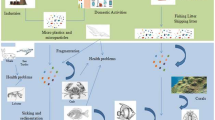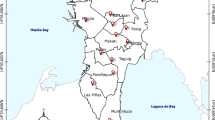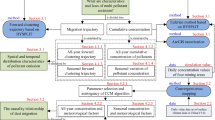Abstract
Exposure to airborne particulate matter (PM) has been associated with various adverse health effects, including severe pulmonary and cardiovascular effects. PM consists of different chemical components that vary with microenvironments in urban areas and pose challenges to assess personal exposure. In Hong Kong, more than 70% of the population commutes through roadway and railway public transport. This study aims to determine the oxidative potential and role of aerosol carbon and water-soluble metals in fine (d p < 2.5 μm) and coarse PM (2.5 <d p <10 μm) in public transport systems including underground (UG) subway, above-ground (AG) train, and buses (BUS). Metals such as Fe, Cr, Mo, Pb, Ni, and V from UG, AG, and BUS routes exhibited much lower solubility compared with ambient PM. The cell toxicity of PM in these transport microenvironments was also analyzed in vitro and compared with urban ambient environments. Strong positive associations were observed for reactive oxygen species (ROS) with water-soluble metals (Cr, Cu, Fe, Mn, Ni, V, Mo; R > 0.70) and organic and elemental carbon (OCEC) (R > 0.85) for UG and AG routes. In addition, PM from UG and AG routes generated 3–4-fold (in PM2.5) and 40–50-fold (in coarse PM) less ROS compared to urban sites, suggesting PM in these public transport microenvironments may not be intrinsically redox active than in urban ambient, and water solubility of metals seems to have played an important role in it.





Similar content being viewed by others
Reference
Aarnio P et al (2005) The concentrations and composition of and exposure to fine particles (PM2.5) in the Helsinki subway system. Atmos Environ 39:5059–5066. doi:10.1016/J.Atmosenv.2005.05.012
Araujo JA (2011) Particulate air pollution, systemic oxidative stress, inflammation, and atherosclerosis. Air Qual Atmos Health 4:79–93. doi:10.1007/s11869-010-0101-8
Birch ME, Cary RA (1996) Elemental carbon-based method for monitoring occupational exposures to particulate diesel exhaust. Aerosol Sci Technol 25:221–241. doi:10.1080/02786829608965393
Boogaard H et al (2012) Contrasts in oxidative potential and other particulate matter characteristics collected near major streets and background locations. Environ Health Perspect 120:185–191. doi:10.1289/ehp.1103667
Chan LY, Lau WL, Lee SC, Chan CY (2002a) Commuter exposure to particulate matter in public transportation modes in Hong Kong. Atmos Environ 36:3363–3373. doi:10.1016/S1352-2310(02)00318-7
Chan LY, Lau WL, Zou SC, Cao ZX, Lai SC (2002b) Exposure level of carbon monoxide and respirable suspended particulate in public transportation modes while commuting in urban, area of Guangzhou, China. Atmos Environ 36:5831–5840. doi:10.1016/S1352-2310(02)00687-8
Cheng Y et al (2015) PM2.5 and PM10-2.5 chemical composition and source apportionment near a Hong Kong roadway. Particuology 18:96–104. doi:10.1016/j.partic.2013.10.003
Chillrud SN, Epstein D, Ross JM, Sax SN, Pederson D, Spengler JD, Kinney PL (2004) Elevated airborne exposures of teenagers to manganese, chromium, and iron from steel dust and New York City’s subway system. Environ Sci Technol 38:732–737. doi:10.1021/Es034734y
Cho AK et al (2005) Redox activity of airborne particulate matter at different sites in the Los Angeles Basin. Environ Res 99:40–47. doi:10.1016/J.Envres.2005.01.003
Donaldson K et al (2002) The pulmonary toxicology of ultrafine particles. J Aerosol Med 15:213–220. doi:10.1089/089426802320282338
Furuya K, Kudo Y, Okinaga K, Yamuki M, Takahashi S, Araki Y, Hisamatsu Y (2001) Seasonal variation and their characterization of suspended particulate matter in the air of subway stations. J Trace Microprobe T 19:469–485. doi:10.1081/Tma-100107583
Gali NK, Yang F, Jiang SY, Chan KL, Sun L, Ho KF, Ning Z (2015) Spatial and seasonal heterogeneity of atmospheric particles induced reactive oxygen species in urban areas and the role of water-soluble metals. Environ Pollut 198:86–96. doi:10.1016/j.envpol.2015.01.001
Ghio AJ, Stonehuerner J, Dailey LA, Carter JD (1999) Metals associated with both the water-soluble and insoluble fractions of an ambient air pollution particle catalyze an oxidative stress. Inhal Toxicol 11:37–49. doi:10.1080/089583799197258
HKTD (2014) Travel characteristics survey. Hong Kong
Ho KF, Lee SC, Chan CK, Yu JC, Chow JC, Yao XH (2003) Characterization of chemical species in PM2.5 and PM10 aerosols in Hong Kong. Atmos Environ 37:31–39. doi:10.1016/S1352-2310(02)00804-X
Hu S, Polidori A, Arhami M, Shafer MM, Schauer JJ, Cho A, Sioutas C (2008) Redox activity and chemical speciation of size fractioned PM in the communities of the Los Angeles-Long Beach harbor. Atmos Chem Phys 8:6439–6451
Jia Y, Wang Q, Liu T (2017) Toxicity research of PM2.5 compositions in vitro. Int J Environ Res Public Health 14:232. doi:10.3390/ijerph14030232
Jiang SYN, Yang FH, Chan KL, Ning Z (2014) Water solubility of metals in coarse PM and PM2.5 in typical urban environment in Hong Kong. Atmos Pollut Res 5:236–244. doi:10.5094/Apr.2014.029
Kam W, Cheung K, Daher N, Sioutas C (2011a) Particulate matter (PM) concentrations in underground and ground-level rail systems of the Los Angeles Metro. Atmos Environ 45:1506–1516. doi:10.1016/J.Atmosenv.2010.12.049
Kam W, Ning Z, Shafer MM, Schauer JJ, Sioutas C (2011b) Chemical characterization and redox potential of coarse and fine particulate matter (PM) in underground and ground-level rail systems of the Los Angeles Metro. Environ Sci Technol 45:6769–6776. doi:10.1021/es201195e
Kim CH et al (2010) A study on characteristics of atmospheric heavy metals in subway station. Toxicol Res 26:157–162. doi:10.5487/TR.2010.26.2.157
van Klaveren RJ, Nemery B (1999) Role of reactive oxygen species in occupational and environmental obstructive pulmonary diseases. Curr Opin Pulm Med 5:118–123
Kleeman MJ, Schauer JJ, Cass GR (2000) Size and composition distribution of fine particulate matter emitted from motor vehicles. Environ Sci Technol 34:1132–1142. doi:10.1021/Es981276y
Lakey PS, Berkemeier T, Tong H, Arangio AM, Lucas K, Poschl U, Shiraiwa M (2016) Chemical exposure-response relationship between air pollutants and reactive oxygen species in the human respiratory tract. Sci Rep 6:32916. doi:10.1038/srep32916
Loxham M, Cooper MJ, Gerlofs-Nijland ME, Cassee FR, Davies DE, Palmer MR, Teagle DAH (2013) Physicochemical characterization of airborne particulate matter at a mainline underground railway station. Environ Sci Technol 47:3614–3622. doi:10.1021/es304481m
Mosmann T (1983) Rapid colorimetric assay for cellular growth and survival: application to proliferation and cytotoxicity assays. J Immunol Methods 65:55–63
Mugica-Alvarez V, Figueroa-Lara J, Romero-Romo M, Sepulveda-Sanchez J, Lopez-Moreno T (2012) Concentrations and properties of airborne particles in the Mexico City subway system. Atmos Environ 49:284–293. doi:10.1016/J.Atmosenv.2011.11.038
Murruni LG et al (2009) Concentrations and elemental composition of particulate matter in the Buenos Aires underground system. Atmos Environ 43:4577–4583. doi:10.1016/J.Atmosenv.2009.06.025
Nieuwenhuijsen MJ, Gomez-Perales JE, Colvile RN (2007) Levels of particulate air pollution, its elemental composition, determinants and health effects in metro systems. Atmos Environ 41:7995–8006. doi:10.1016/J.Atmosenv.2007.08.002
Ning Z, Geller MD, Moore KF, Sheesley R, Schauer JJ, Sioutas C (2007) Daily variation in chemical characteristics of urban ultrafine aerosols and inference of their sources. Environ Sci Technol 41:6000–6006. doi:10.1021/Es070653g
Ntziachristos L, Froines JR, Cho AK, Sioutas C (2007) Relationship between redox activity and chemical speciation of size-fractionated particulate matter. Particle and Fibre Toxicology 4:5–5. doi:10.1186/1743-8977-4-5
Pakbin P, Ning Z, Shafer MM, Schauer JJ, Sioutas C (2011) Seasonal and spatial coarse particle elemental concentrations in the Los Angeles area. Aerosol Sci Technol 45:949–U156. doi:10.1080/02786826.2011.571309
Querol X et al (2012) Variability of levels and composition of PM10 and PM2.5 in the Barcelona metro system. Atmos Chem Phys 12:5055–5076. doi:10.5194/Acp-12-5055-2012
Raut JC, Chazette P, Fortain A (2009) Link between aerosol optical, microphysical and chemical measurements in an underground railway station in Paris. Atmos Environ 43:860–868. doi:10.1016/J.Atmosenv.2008.10.038
Rees SL, Robinson AL, Khlystov A, Stanier CO, Pandis SN (2004) Mass balance closure and the federal reference method for PM2.5 in Pittsburgh. Pennsylvania Atmos Environ 38:3305–3318. doi:10.1016/J.Atmosenv.2004.03.016
Roy R, Jan R, Yadav S et al (2016) Study of metals in radical-mediated toxicity of particulate matter in indoor environments of Pune. India Air Qual Atmos Health 9:669–680. doi:10.1007/s11869-015-0376-x
Sabin LD et al (2005) Characterizing the range of children’s air pollutant exposure during school bus commutes. J Expo Anal Environ Epidemiol 15:377–387. doi:10.1038/sj.jea.7500414
Salma I, Weidinger T, Maenhaut W (2007) Time-resolved mass concentration, composition and sources of aerosol particles in a metropolitan underground railway station. Atmos Environ 41:8391–8405. doi:10.1016/J.Atmosenv.2007.06.017
Salma I, Posfai M, Kovacs K, Kuzmann E, Homonnay Z, Posta J (2009) Properties and sources of individual particles and some chemical species in the aerosol of a metropolitan underground railway station. Atmos Environ 43:3460–3466. doi:10.1016/J.Atmosenv.2009.04.042
Spagnolo AM, Ottria G, Perdelli F, Cristina ML (2015) Chemical characterisation of the coarse and fine particulate matter in the environment of an underground railway system: cytotoxic effects and oxidative stress-a preliminary study. Int J Environ Res Public Health 12:4031–4046. doi:10.3390/ijerph120404031
Steenhof M et al (2011) In vitro toxicity of particulate matter (PM) collected at different sites in the Netherlands is associated with PM composition, size fraction and oxidative potential—the RAPTES project. Particle and Fibre Toxicology 8:26. doi:10.1186/1743-8977-8-26
Tao F, Gonzalez-Flecha B, Kobzik L (2003) Reactive oxygen species in pulmonary inflammation by ambient particulates. Free Radical Bio Med 35:327–340. doi:10.1016/S0891-5849(03)00280-6
Valavanidis A, Fiotakis K, Vlachogianni T (2008) Airborne particulate matter and human health: toxicological assessment and importance of size and composition of particles for oxidative damage and carcinogenic mechanisms. J Environ Sci Heal C 26:339–362. doi:10.1080/10590500802494538
Wang DB, Pakbin P, Shafer MM, Antkiewicz D, Schauer JJ, Sioutas C (2013) Macrophage reactive oxygen species activity of water-soluble and water-insoluble fractions of ambient coarse, PM2.5 and ultrafine particulate matter (PM) in Los Angeles. Atmos Environ 77:301–310. doi:10.1016/J.Atmosenv.2013.05.031
Xia T, Korge P, Weiss JN, Li N, Venkatesen MI, Sioutas C, Nel A (2004) Quinones and aromatic chemical compounds in particulate matter induce mitochondrial dysfunction: implications for ultrafine particle toxicity. Environ Health Perspect 112:1347–1358
Yang FH et al (2015) Heterogeneity of passenger exposure to air pollutants in public transport microenvironments. Atmos Environ 109:42–51. doi:10.1016/j.atmosenv.2015.03.009
Ye XJ, Lian ZW, Jiang CX, Zhou ZX, Chen HX (2010) Investigation of indoor environmental quality in Shanghai metro stations. China Environ Monit Assess 167:643–651. doi:10.1007/S10661-009-1080-9
Yip M, Madl P, Wiegand A, Hofmann W (2006) Exposure assessment of diesel bus emissions. Int J Environ Res Public Health 3:309–315
Yue H, Wei W, Yue Z, Lv P, Wang L, Ma G, Su Z (2010) Particle size affects the cellular response in macrophages. Eur J Pharm Sci: Off J Eur Federation Pharm Sci 41:650–657. doi:10.1016/j.ejps.2010.09.006
Zhang Z, Chau PY, Lai HK, Wong CM (2009) A review of effects of particulate matter-associated nickel and vanadium species on cardiovascular and respiratory systems. Int J Environ Health Res 19:175–185. doi:10.1080/09603120802460392
Acknowledgements
The authors wish to thank Food and Health Bureau, Hong Kong SAR Government, for the grant of Health and Medical Research Fund (HMRF; Ref. No. 10112061). The authors would also like to acknowledge the financial support of General Research Fund (GRF Project. No. 11204115) and the Early Career Scheme (ECS Project No. 21201214) from the Research Grants Council of the Hong Kong SAR. The authors report no conflict of interest with funding sources and others.
Author information
Authors and Affiliations
Corresponding author
Ethics declarations
Funding
This study was funded by Research Grants Council of the Hong Kong SAR (GRF Project. No. 11204115 and ECS Project No. 21201214). Also, Food and Health Bureau, Hong Kong SAR Government funded this study (HMRF; Ref. No. 10112061).
Conflict of interest
The corresponding author Zhi NING received the above-said grants and declares no conflict of interest with funding sources and others.
Human and animal rights and informed consent
This study did not employ either human participants or animals for the experiments.
The authors declare that this manuscript is submitted solely to this journal and is not in consideration/in publication with any other journal.
Electronic supplementary material
ESM 1
(DOC 671 kb)
Rights and permissions
About this article
Cite this article
Gali, N.K., Jiang, S.Y., Yang, F. et al. Redox characteristics of size-segregated PM from different public transport microenvironments in Hong Kong. Air Qual Atmos Health 10, 833–844 (2017). https://doi.org/10.1007/s11869-017-0473-0
Received:
Accepted:
Published:
Issue Date:
DOI: https://doi.org/10.1007/s11869-017-0473-0




